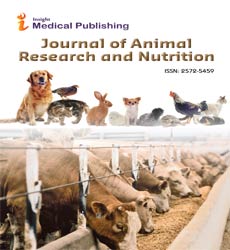Abstract
Udder Morphology, Milk Quality and Milk Composition of Saanen Goat at NGRP Bandipur
Goat farming plays a crucial role in meeting global demands for meat and dairy products, especially in Nepal, where it contributes significantly to agricultural GDP and rural livelihoods. The introduction of Saanen goats, known for their prolific milk production, has the potential to revolutionize goat farming in Nepal. This study, carried out over a 28-day period involving 10 Saanen goats at the late lactation stage assesses udder morphology, milk composition, and milk quality in Saanen goats at the national goat research program, Bandipur, Nepal. The results indicate that most goats have symmetrical, globular udders and funnel shaped teats. Somatic Cell Count (SCC) values consistently remained within the normal range throughout the duration of the study, with the notable observation that SCC values were higher in the right teat (1137242 cells/ml) compared to left teat (352676 cells/ml) and teat-to-ground distance notably impacted SCC, especially in the left teat. The right teat did not significantly affect SCC, possibly due to individual variations. Milk composition remained stable, with minor fluctuations, and physical udder measurements showed significant variations in udder circumference and width, possibly linked to milk production. The study highlights the potential for sustainable high-quality milk production in Saanen goats in Nepal and offers insights for early health issue detection, fostering effective herd management and productivity. Further research with larger sample sizes and different lactation stages can provide more comprehensive insights into Saanen goat farming in Nepal.
Author(s): Dr. Ayush Adhikari and Dr. Sagun Malla
Abstract | Full-Text | PDF
Share this

Google scholar citation report
Citations : 764
Journal of Animal Research and Nutrition received 764 citations as per google scholar report
Abstracted/Indexed in
- Google Scholar
- China National Knowledge Infrastructure (CNKI)
- WorldCat
- International Committee of Medical Journal Editors (ICMJE)
- Secret Search Engine Labs
Open Access Journals
- Aquaculture & Veterinary Science
- Chemistry & Chemical Sciences
- Clinical Sciences
- Engineering
- General Science
- Genetics & Molecular Biology
- Health Care & Nursing
- Immunology & Microbiology
- Materials Science
- Mathematics & Physics
- Medical Sciences
- Neurology & Psychiatry
- Oncology & Cancer Science
- Pharmaceutical Sciences

